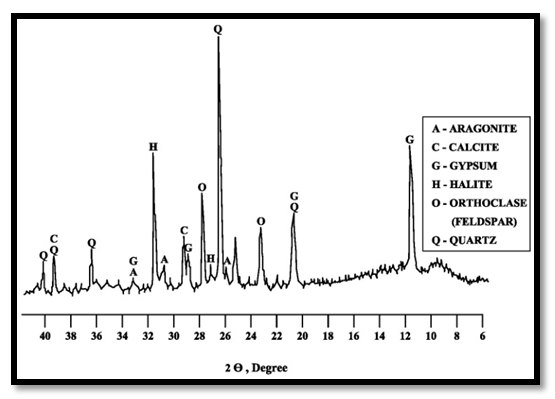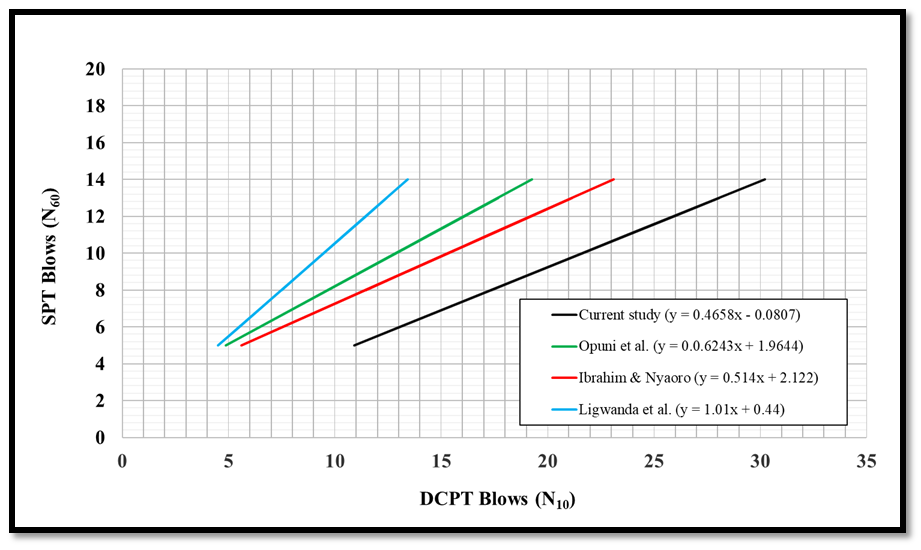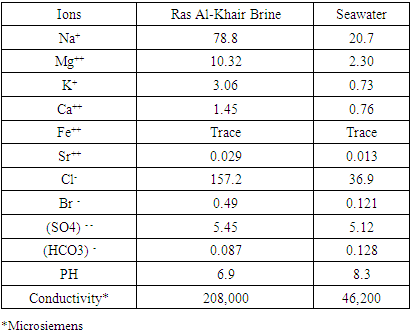-
Paper Information
- Paper Submission
-
Journal Information
- About This Journal
- Editorial Board
- Current Issue
- Archive
- Author Guidelines
- Contact Us
Journal of Civil Engineering Research
p-ISSN: 2163-2316 e-ISSN: 2163-2340
2025; 15(1): 10-16
doi:10.5923/j.jce.20251501.02
Received: May 14, 2025; Accepted: Jun. 8, 2025; Published: Jun. 16, 2025

Development of SPT and DCPT Correlation for Sabkha Soils of Ras Al Khair in Eastern Saudi Arabia
Emmanouil Spyropoulos1, John Fahd Touma2, Muhammad Abdul Waheed3, Muhammad Fayyaz4
1Engineering Consultant, Equipment Consulting Services Department, Saudi Aramco, Saudi Arabia
2Director, Riyadh Geotechnique & Foundations (RGF), Saudi Arabia
3Regional Manager, Riyadh Geotechnique & Foundations (RGF), Saudi Arabia
4Senior Geotechnical Engineer, Riyadh Geotechnique & Foundations (RGF), Saudi Arabia
Correspondence to: Emmanouil Spyropoulos, Engineering Consultant, Equipment Consulting Services Department, Saudi Aramco, Saudi Arabia.
| Email: |  |
Copyright © 2025 The Author(s). Published by Scientific & Academic Publishing.
This work is licensed under the Creative Commons Attribution International License (CC BY).
http://creativecommons.org/licenses/by/4.0/

Standard Penetration Test (SPT) is commonly used to delineate subsurface strata conditions in routine geotechnical investigation campaign and provides quite useful information on the nature and type of the subsurface strata. Many geotechnical parameters of soils are associated with SPT and several SPT design correlations exist for foundation design. SPT is generally performed using automatic hammers equipped on truck mounted drilling rigs. Sabkha is a saline (generally coastal) deposit consisting of saturated, loose silty sand and clay. Sabkhas are not traversable for any kind of vehicle and drilling trucks often get stuck in sabkha areas, causing damage to the equipment. This limitation of vehicle movement restricts the acquisition of SPT data in sabkha areas which are prevalent in major parts of eastern Saudi Arabia. Dynamic Cone Penetration Test (DCPT) can be used as a good alternative to SPT in sabkha areas due to its portable tripod-based equipment. In this study, SPT and DCPT tests are carried out side by side on several sabkha sites and correlations are developed between SPT and DCPT data. The results indicate that a good correlation exists between both dynamic tests. The developed SPT and DCPT correlation can be effectively used to utilize well-established relationships between SPT and soil properties for sabkha deposits.
Keywords: Standard Penetration Test, Dynamic cone penetration test, Sabkha soils, SPT-DCPT correlations
Cite this paper: Emmanouil Spyropoulos, John Fahd Touma, Muhammad Abdul Waheed, Muhammad Fayyaz, Development of SPT and DCPT Correlation for Sabkha Soils of Ras Al Khair in Eastern Saudi Arabia, Journal of Civil Engineering Research, Vol. 15 No. 1, 2025, pp. 10-16. doi: 10.5923/j.jce.20251501.02.
Article Outline
1. Introduction
- During any standard geotechnical investigation program, a variety of field-testing methods are adopted, each with its own set of advantages and limitations. Among these, the Standard Penetration Test (SPT) is one of the most widely used techniques for identifying the strength, nature and classification of subsurface strata. Its popularity stems from the extensive database of empirical correlations that link SPT results with various geotechnical design parameters. These correlations make the SPT a valuable tool in estimating soil properties critical for design purposes. Dynamic Cone Penetration Test (DCPT) is another penetration-based field test applied, usually, for pavement investigations 21,24,27. However, DCPT can also be used effectively as geotechnical investigation and foundation design tool 15,17,18. The main advantages of DCPT over SPT are; (i) it is fast as no drilling operation is required, (iii) profiling is continuous, (iii) inexpensive, and (iv) particularly useful to investigate weak soil layers such as sabkhas. However, its major limitation is non retrieval of samples and limited penetration in very dense and hard materials. Individually, each of these tests has its own limitations, but when used together, the SPT and DCPT can complement one another, providing a more comprehensive understanding of subsurface conditions that might not be fully uncovered by either test alone.The coastal areas of Saudi Arabia, the east coast is surfaced with sabkha soils 3,5,19. The sabkhas are identified by high concentrations of salt, shallow water tables and low shear strength 12. As per Saudi Building Code 26, Sabkhas are salt bearing arid climate sediments. The sabkha sediments are highly variable in lateral and vertical extent; various soil types, primarily composed of clays, silts, fine sands, and organic matter are interlayered at random 7,9,10. In general, sabkha sediments are characterized by high void ratios and low dry densities 1,2. Accordingly, upon wetting sabkha soil is renowned for being highly compressible material with low bearing resistance, and hence considered among the poorest of foundation materials 1,2,6-11. Sabkha areas are generally inaccessible to vehicles, and drilling rigs often become stuck, posing a risk of equipment damage. This restriction on vehicle movement creates significant challenges in conducting Standard Penetration Tests (SPT), limiting the availability and reliability of subsurface data in these regions. In sabkha regions, the Dynamic Cone Penetration Test (DCPT) offers a viable alternative to the Standard Penetration Test (SPT), thanks to its portable, tripod-based equipment that allows for easier deployment in areas with limited accessibility.DCPT has been correlated in literature with SPT as a supplementary test to reduce the number of SPT boreholes as well as for design of shallow foundations. SPT and DCPT correlations are generally used for subsurface strata strength classification, translation of SPT blow counts (N-values) into DCPT blow counts (N10-values) and vice versa. The primary aim of converting one geotechnical parameter to another is to make effective use of the extensive correlation data available in the literature, which is typically developed through local experience, field measurements, design practices, and engineering preferences. Several studies 13,14,16,22,23,28 have been performed to develop SPT-DCPT correlations in the past. Various efforts have also been made to utilize the Dynamic Cone Penetrometer Test (DCPT) in estimating the allowable bearing capacity of shallow foundations. 22 developed a correlation to assess the bearing capacity of shallow foundations for sandy soils in Ghana. In Tanzania, 23 established correlations between DCPT and SPT results for sandy soils. 20 also developed relationships between DCPT and SPT values to estimate the bearing capacities of foundations. However, all presented relationships cannot be used universally due to variations in different types of DCPT equipment worldwide and non-establishment of corrections related to hammer efficiency, overburden correction etc. to the DCPT procedures 28. Therefore, it is essential to develop a correlation between SPT and DCPT for local sabkha soils.In the eastern region of Saudi Arabia, especially along the coastal areas, the soils are predominantly calcareous and often exhibit cementation, accompanied by shallow groundwater levels 29. As a result, examining the relationship between Standard Penetration Test (SPT) N-values and Dynamic Cone Penetration Test (DCPT) for these local soil conditions can be highly beneficial for any future construction in these areas. Such correlations can enhance the understanding of subsurface soil behavior and response as reflected in both testing approaches.
2. Sites and Investigation Description
- This study utilizes a dataset comprising Dynamic Cone Penetration Test (DCPT) soundings and Standard Penetration Test (SPT) profiles obtained from three sites of Ras Al Khair area (Site 1, Site 2, and Site 3) located in the eastern coastal region of Saudi Arabia. The locations of these sites are illustrated in Figure 1. Each site includes data from ten boreholes and ten corresponding DCPTs. The DCPTs were conducted at distances ranging from 3.0 to 5.0 meters from the SPT boreholes to maintain proximity while minimizing interference between tests.
 | Figure 1. Vicinity Map showing locations of investigated sites |
|
 | Figure 2. X-ray diffraction analysis of sabkha sample 8 |
3. SPT and DCPT Data Analysis
- Standard Penetration Tests (SPTs) were conducted using automatic hammers at 0.50 meter depth intervals, extending to a maximum depth of 6.0 meters. The data obtained from these tests were used to evaluate the in-situ compactness or density of the subsurface materials. SPT blow counts for the final 30 cm penetration were referred as N-values. For all boreholes across the three study sites, the recorded SPT-N values were normalized to N₆₀ by applying energy and other relevant correction factors. Additionally, DCPT values (N₁₀) were extracted from averaging the DCPT soundings at depths corresponding to those of the SPTs against each 30 cm penetration.From the thirty (30) SPT boreholes and corresponding DCPTs, approximately one hundred and fifty (150) data pairs of normalized SPT values (N₆₀) and DCPT values (N₁₀) were available for comparative analysis. However, to illustrate the correlation process, a typical subset of data points has been presented in Table 2.
|
 | Figure 3. Plot of SPT and DCPT values for investigated sites |
|
 | Figure 4. Validation of SPT and DCPT correlation using data of Site 4 |
4. Results and Discussions
- The developed correlation between SPT and DCPT values for local sabkha soils suggest that a strong relationship exists between both parameters. Using regression analysis, an expression of N30 = 0.4658xN10 - 0.0807 was obtained with an associated coefficient of determination of R² = 0.9392. The correlation obtained in this study is also plotted with the existing SPT and DCPT correlations by 22, 20 and 23 for data of Site 4 and results are provided in Figure 5. The existing correlations are not matching well with the one developed in the current study. The reasons could be that the correlation by 22 is based on N70 whereas the one suggested in this study is based on N60 values. 20 developed the correlation for clayey sands whereas sabkha soils tested in this study are sandy in nature. Another notable reason for this discrepancy could also be the cementation among the soil particles of sabkha soils, resulting from the precipitation of salts such as Aragonite, Calcite, Gypsum and sodium chloride etc. in sabkha layers (Figure 2). The precipitation of salts occurs as a result of repeated cycles of capillary rise and evaporation in the soil layers, driven by fluctuations in ambient temperature, humidity, precipitation, and tidal variations. This cementation has resulted in higher SPT and DCPT values as compared to other correlations presented in literature where no such cementation is reported in the tested soils.
 | Figure 5. Comparison of different SPT and DCPT correlations |
5. Conclusions
- Sabkha areas are generally inaccessible to drilling rigs due to their low shear strength and high collapsibility, which significantly limits the acquisition of Standard Penetration Test (SPT) data. However, the Dynamic Cone Penetration Test (DCPT) offers a practical alternative in such environments, as its portable and lightweight nature makes it well-suited for use in these challenging ground conditions.In this study, SPT and DCPT tests are carried out side by side on several sabkha sites and a site-specific correlation (N30 = 0.4658xN10 - 0.0807) is developed between SPT and DCPT for Sabkha soils. Since many geotechnical soil parameters are commonly correlated with SPT results, and numerous SPT-based empirical relationships are available in the literature for deriving foundation design parameters, the established correlation between SPT and DCPT for local Sabkha soils can be effectively used to convert DCPT values into equivalent SPT values. This facilitates the application of the extensive database of SPT-based correlations for Sabkha soils where only DCPT data can be collected.
6. Recommendations
- Due to the inherent limitations and simplified assumptions in DCPT-based correlations for estimating allowable bearing capacity, it is recommended to use SPT-based methods for bearing capacity evaluation. This can be achieved by first converting DCPT values into equivalent SPT values using the established correlations, and then applying SPT-based approaches for bearing capacity evaluation.
 Abstract
Abstract Reference
Reference Full-Text PDF
Full-Text PDF Full-text HTML
Full-text HTML

